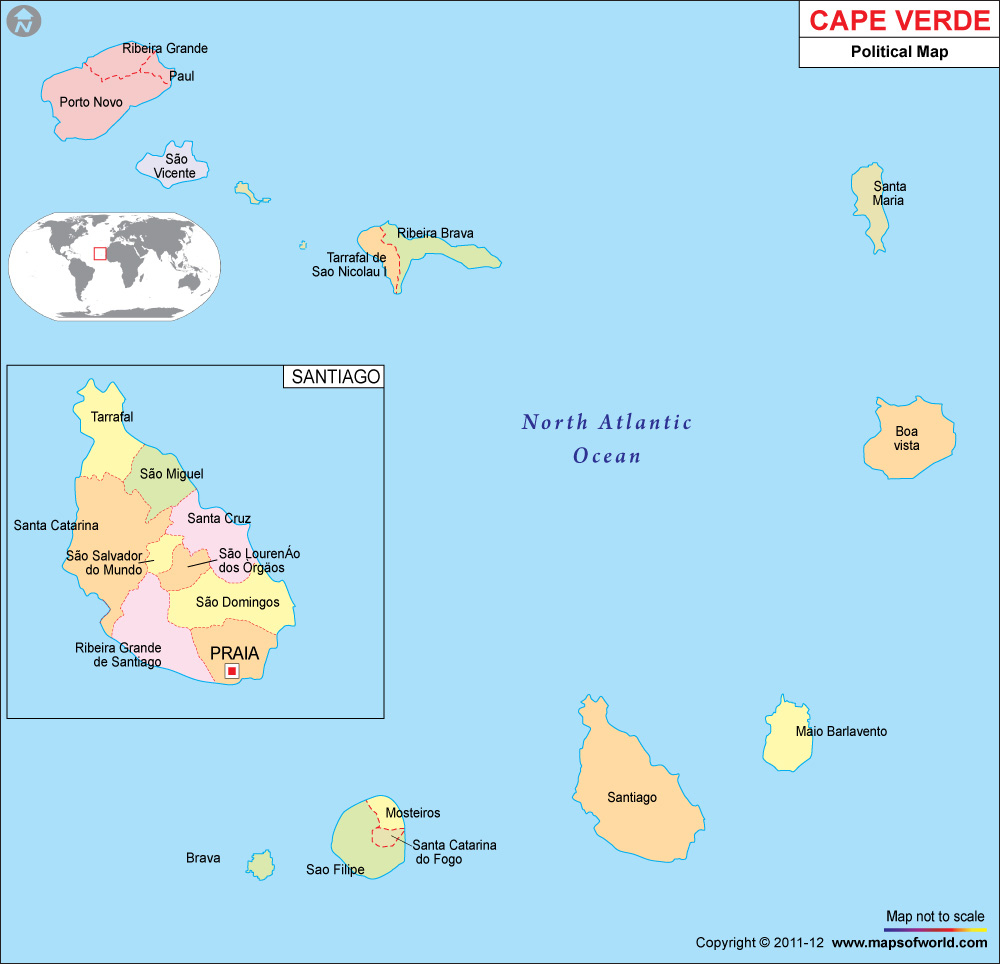Cape Verde Map

- Continent And Regions - Africa Map
- Other Cape Verde Maps - Where is Cape Verde, Cape Verde Blank Map, Cape Verde Road Map, Cape Verde Cities Map, Cape Verde Physical Map, Cape Verde Flag
About Cape Verde
Explore this Cape Verde map to learn everything you want to know about this country. Learn about Cape Verde location on the world map, official symbol, flag, geography, climate, postal/area/zip codes, time zones, etc. Check out Cape Verde history, significant states, provinces/districts, & cities, most popular travel destinations and attractions, the capital city’s location, facts and trivia, and many more.
| Official Name | (Republic of Cape Verde) Republica de Cabo Verde |
| Capital | Praia |
| Population | 437,000 |
| Area | 4033 sq km or 1557 sq mi |
| Currency | Escudo ($1=119.75) |
| Religion | Christianity |
| Literacy | 72% |
| Languages | Portuguese |
| Climate | Tropical and dry |
An archipelago consisting of 15 islands, Cape Verde became an independent nation on July 5, 1975. This country situated in the Atlantic has suffered many droughts, which have made the country slightly poore.
Physical Map of Cape Verde
Most of the islands are volcanic in origin with three-Sal, Boa Vista, and Maio-being mountainous. The highest point, Pico do Cano rising to 9,281 ft on Fogo, is the group’s only active volcano. Mineral resources are meager and primarily include pozzolana, a volcanic rock used in making cement; and salt.
This country lacks renewable sources of fresh water and is often subject to droughts.
Location of Cape Verde
Cape Verde islands are located in the Atlantic ocean, due west of the westernmost point of Africa, Cape Verde. These islands can be divided into windward and leeward groups. The windward, or Barlavento, group on the north includes Santo Antão, São Vicente, São Nicolau, Santa Luzia, Sal, and Boa Vista while the leeward, or Sotavento, group on the south includes São Tiago, Brava, Fogo, and Maio.
Flag of Cape Verde
The flag of Cape Verde consists of three horizontal bands -light blue at the top (double width), white with a horizontal red stripe in the middle and again light blue at the bottom. A circle of 10 yellow five-pointed stars is present in the center on the hoist end of the red stripe and extends into the upper and lower blue bands.
Climate of Cape Verde
The climate is tropical and dry, showing little variation throughout the year. The average temperature in Praia, the capital, ranges from 20° to 25°C in January and 24° to 28°C in July. Winds are frequent, occasionally carrying clouds of sand from the Sahara Desert in Africa to the east. Rainfall is less and irregular. Average rainfall in Praia is 260 mm, nearly all of which falls from August through September.
Flora And Fauna of Cape Verde
Vegetation is sparse and consists of various shrubs, aloes, and other drought-resistant species. Wildlife is also limited and includes lizards, monkeys, wild goats, and a variety of bird life.
People of Cape Verde
The people of Cape Verde, more than two-thirds of them, consists of mixed African and European ancestry and are known as Creoles, or mesticos.The remaining population is mainly made up of people with African ancestry. Though the official language is Portuguese, the national language is Crioulo, a Creole dialect of archaic Portuguese incorporating many African elements. Roman Catholicism is the dominant religion and literacy is spread among some 77 percent of the population.
Economy of Cape Verde
Agriculture forms the main source of economy, despite the fact that cultivable land accounts for only 9.7 percent of the total land, which is again affected by frequent droughts. The crops produced include maize and beans and also sweet potatoes, coconuts, potatoes, cassava, and dates. Bananas are also grown for export, and sugarcane is raised for the making of rum. Apart from this, Cape Verde has rich fishing potential as it is located in the midst of fishing grounds, but the industry has yet to develop. Salt is mined on Sal, Boa Vista, and Maio, with annual production of about 7,000 metric tons. However, depressed by the lack of steady markets and readily available ocean transportation, the production has declined to less than one-quarter of the level achieved in the 1970s.